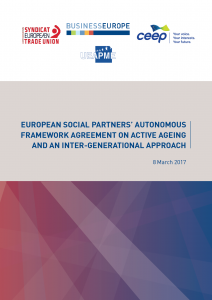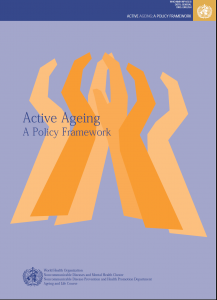Active ageing can mean many different things and it is used in many different institutional contexts. In fact, the term should really be plural instead of singular. Because different institutions have different understandings of what active ageing is and what it entails, it can be helpful to look at some examples. A brief review of institutional conceptualizations of active ageing. Below we provide a brief review of institutional conceptualizations of active ageing.
The European Social Partners

The European social partners (ETUC, Business Europe, CEEP, UEAPME) agreed a framework agreement on active ageing and an inter-generational approach. The agreement calls for measures to support older workers to stay economically active at least up until retirement age while at the same time ensuring that young people have pathways into secure and high quality work. It is therefore not just about extending working life, but also to ensure “a culture of responsibility, commitment, respect and dignity in all workplaces where all workers are valued as important irrespective of age.”
Importantly, the agreement calls for initiatives at the national, sectoral, company and workplace levels. In other words, active ageing isn’t just something which is decided at the national level and imposed top-down, but an issue which managers and trade union representatives at all levels can engage in. Sometimes, the most innovative practices start at the workplace level and are shared between social partners in workplaces facing similar problems.
Social partners recommend social partners focus on the following areas:
- Conducting a strategic assessment on workforce demography
- Identify and remedy health and safety risk factors
- Manage skills and competencies across the life course
- Consider ways to reorganise work for healthy and productive lives
- Promote an intergenerational approach to work.
We provide detailed approaches to all five of these initiatives drawn from the four countries.
The European Commission

The document entitled The EU Contribution to Active Ageing and Solidarity between Generations, published by the European Commission in 2012, says that active ageing principally means three things (bold and underlined emphasis added):
- Enabling both women and men to remain in employment longer – by overcoming structural barriers (including a lack of support for informal carers) and offering appropriate incentives. Many older people can be helped to remain active in the labour market, with systemic and individual benefits.
- Facilitating active citizenship through enabling environments that harness the contribution that older women and men can make to society.
- Enabling both women and men to keep in good health and to live independently as they grow older, thanks to a life-course approach to healthy ageing combined with adapted housing and local environments that allow elderly people to remain in their own homes as long as possible.
According to the European Commission, the only way that Europe will be able to meet the challenges of demographic change is through active ageing. This concept was developed mainly in regard to older people.
The United Nations Economic Commission for Europe and the World Health Organization
In the same year, 2012, the United Nations Economic Commission for Europe (UNECE) released a policy brief on active ageing. The concept used in the brief is based on the broader view of active ageing put forward by the World Health Organization (WHO) (bold and underlined emphasis added):

“Active ageing is the process of optimizing opportunities for health, participation and security in order to enhance quality of life as people age. […] Active ageing allows people to realize their potential for physical, social, and mental well-being throughout the life course and to participate in society, while providing them with adequate protection, security and care when they need it.” The definition strongly associates with the well-being of individuals. However, the well-being of persons is not only an individual luxury, but has an ultimate societal dimension in terms of an increase in labour market participation and a decrease of health care expenditures, for instance.
This concept of active ageing brings together various social and political domains: labour market participation, social inclusion, and health. It is concerned with people as they age. Recently, WHO has changed its focus from ‘active ageing’ to ‘healthy ageing’ (the latter concentrates on functional ability and well-being in older age).
Lessons learned
- Active ageing is not just about working longer. It is mainly about ageing better.
- Employment needs to be combined with other dimensions, such as social participation, health and security, to make active ageing possible.
- Active ageing is not only about the well-being of older people, but about the well-being of individuals as they age, i.e. throughout their lives.
- In practice, active ageing requires collaboration between responsibility and choice at the individual level and society’s effort to make available resources and opportunities to age actively.
- Active ageing should never be an obligation but rather an option. Ageing actively is not the only way to age well.








